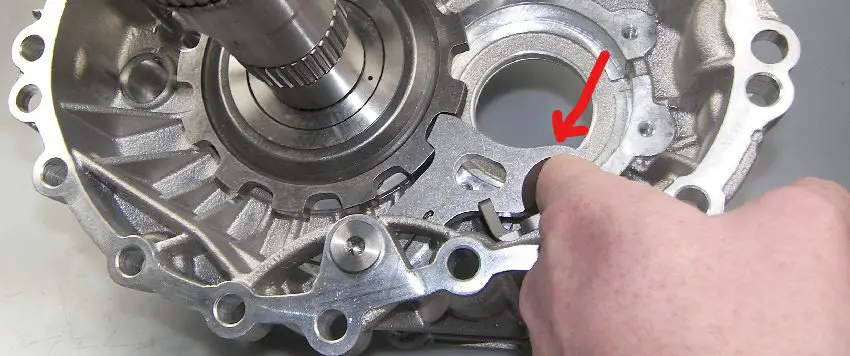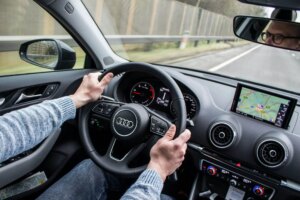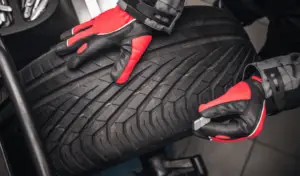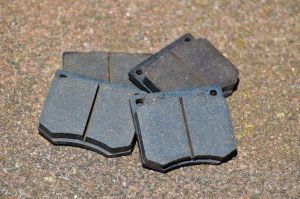Do Automatics Roll Forward or Backward When Put in Park?
It is normal for a vehicle to roll slightly forward or backward when shifted into Park. If it moves more than a few inches, that’s a worry. If it rolls more than this, it indicates a transmission problem.
The Mechanism:
The parking gear relies on locking the driveshaft, so the wheels don’t turn.
It does so with the help of a device called the parking pawl engages a pin that locks the output shaft in the transmission to the casing.

The pin catches onto the teeth of the gear cog, so there may be slight movement before both contact and lock up. If your car moves less than a few inches, it is entirely normal.
Can Putting a Car in Park Stop it From Rolling?
Automatics with park gear have sensors and software to stop the pin from engaging the output shaft when the car moves too fast to avoid damage. At low speeds(moving a few inches), it will stop the car but should not be used to brake.
How to Avoid Damage
To avoid any damage, experts recommend using the parking brake/E-Brake/Hand brake as the primary means of keeping the car still. Once the E-Brake has been pulled, the parking gear could be selected as a backup option if the main E-Brake fails.
This is because the parking gear depends upon the transmission and driveshaft of your vehicle. When relying mainly on the Park Gear, it puts a lot of strain on transmission components and may damage the parking pawl, the gear’s teeth, or worse, bend the output shaft itself.
Signs and Damage
If your automatic car rolls more than a few inches even when selecting Park gear, your U-Joint or parking pawl is badly damaged. For rear-wheel drive vehicles, if the Universal Joint(U-joint) is damaged, the car will also have difficulty moving when in gear. Grinding noises normally accompany this.
If it is not that, the parking pawl has been damaged. Often the pin that holds the gear breaks. There is no noise when the car rolls backward or forwards in park gear as it is essentially freewheeling and not catching the teeth.
Sometimes your pin is intact, but the spring and the actuators (the motor and electrical components) that engage the pin have failed and are not directing it to move ahead once you engage the “P” gear.
If you hear a clicking sound while the car moves in park gear, the pin is intact and engaged, but the gear cog’s teeth are worn. Hence the pin and the teeth slide past each other and do not grip quickly as needed.
Can I Continue Driving Without Getting It Fixed?
Driving around with broken Parking Gear is not an issue. The car will go forward and reverse normally without the park gear working, as it is only used to stop the car. If you can avoid using the “P Gear,” it is not important to fix and would not worsen over time.
But still, get a skilled transmission expert to check the car and see if the issue stays specific to the park gear or is a wider gear problem.
Fixes and Replacement Costs
Anything related to your transmission is generally an expensive job. A mechanic would need to detach the transmission from the vehicle and pull it apart to check for items that need replacing and fixing.
This on its own is a time and energy-consuming task, so be prepared to pay for a few hours of labor. These jobs can often cost $500 or above.
As for the parts only, the pin and springs are usually not expensive items. The parking pawl kit with shaft, pin, and springs is usually around $25.
The other components, such as the actuator, are also generally cheap, starting at about $10-25. This varies a little, depending on your car’s make and model.
If it is neither of them, the gear cog or the output shaft itself are much more expensive parts in comparison.
How To Park Your Car Correctly To Avoid Rolling
Stick Shift Manual Cars
Always engage the parking brake before releasing your foot from the brake pedal. Failing to do this means that for the time between you releasing your foot off the brake pedal and engaging the parking brake, the parking pawl and your transmission carry the burden of keeping your car stationary.
Automatic Transmission
The process is pretty much the same for automatics. It’s about relieving some pressure off a very expensive car part – the transmission. You’ll take away this burden by ensuring you always have either the footbrake or parking brake on.
In Conclusion
It’s normal for your car to roll a little in Park, but more than a few inches is not normal and should be investigated further. If this happens, be safe by parking on the level until you get to a mechanic.
Most replacement parts are cheap, but labor costs can be high due to the parts that may have to be removed to get to the part that needs replacing. This video shows the parking pawl in action.













